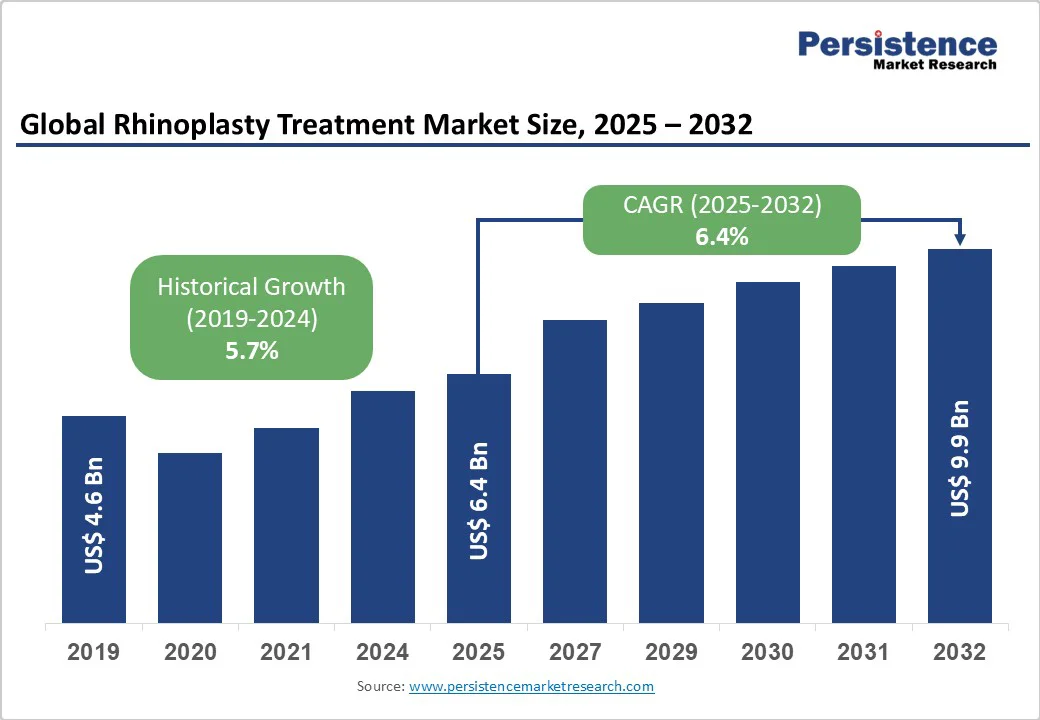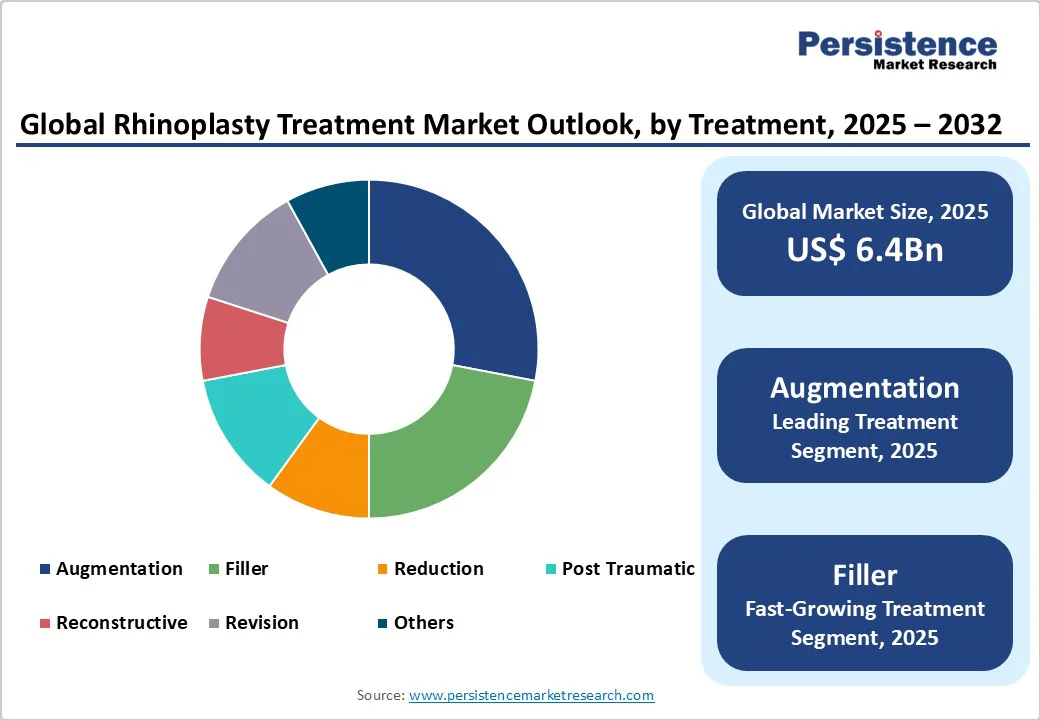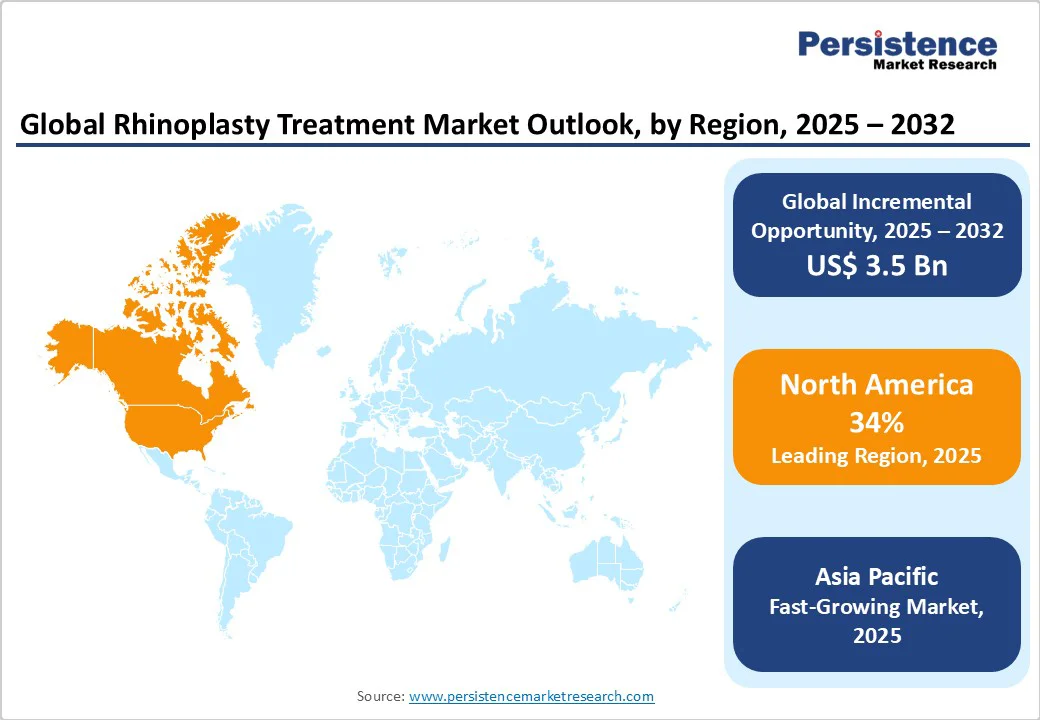ID: PMRREP26872| 198 Pages | 1 Oct 2025 | Format: PDF, Excel, PPT* | Healthcare

The global rhinoplasty treatment market size is likely to be valued at US$6.4 Bn in 2025 and expected to reach US$9.9 Bn by 2032, registering a robust CAGR of 6.4% during the forecast period from 2025 to 2032, fueled by the increasing demand for aesthetic enhancements, advancements in surgical techniques, and a global push toward improving facial harmony and functional nasal corrections.
| Key Insights | Details |
|---|---|
| Rhinoplasty Treatment Market Size (2025E) | US$6.4 Bn |
| Market Value Forecast (2032F) | US$9.9 Bn |
| Projected Growth (CAGR 2025 to 2032) | 6.4% |
| Historical Market Growth (CAGR 2019 to 2024) | 5.7% |

The global surge in demand for aesthetic enhancements is a primary driver of the rhinoplasty treatment market. According to the International Society of Aesthetic Plastic Surgery (ISAPS), rhinoplasty procedures worldwide reached approximately 1.2 Mn in 2023, with projections estimating a rise to 1.8 Mn by the end of 2025, driven by the technology enabling precise contouring essential for facial symmetry and self-esteem boosts in diverse populations.
The rising prevalence of appearance-related concerns is being amplified by the expanding influence of social media platforms, where global audiences are continually exposed to idealized beauty standards. This trend, coupled with increasing lifestyle-driven self-image anxieties, has positioned cosmetic surgeries, particularly rhinoplasty, as a leading global enhancement choice.
Governments and healthcare providers are responding with substantial investments in specialized clinics, with the United States at the forefront in adopting advanced rhinoplasty techniques tailored for ethnic-specific refinements that address personalization needs. In Europe, steady growth in aesthetic procedures is supported by initiatives such as health equity programs introduced by the European Commission, emphasizing accessible cosmetic treatments.
The cosmetics sector, a key contributor to global wellness spending, is leveraging rhinoplasty to address aging-related and congenital concerns in regions with limited procedure availability. In Asia Pacific, rising demand from younger populations for solutions such as augmentation and filler-based procedures is driving market expansion. Increasing investments in patient-centric research and advanced surgical innovations further sustain long-term growth, with emerging economies embracing public-private partnerships and technology transfers.
The high costs associated with rhinoplasty remain one of the most significant barriers to market expansion. Expenses typically include surgeon fees, anesthesia, facility charges, and extensive post-operative care, making such procedures largely inaccessible to lower-income groups and restricting demand to affluent demographics.
Beyond cost, regulatory challenges add another layer of complexity. In regions such as the United States and Europe, stringent compliance requirements, including safety certifications and clinical validation, prolong the time to market for new implants and innovative techniques. These processes, while crucial for patient safety, often drive up development costs and slow the adoption of cutting-edge solutions.
In emerging economies, evolving regulatory frameworks can further complicate market entry, limiting the scalability and availability of advanced treatments. Collectively, these challenges create disparities in access to rhinoplasty services, with affordability and regulatory hurdles slowing adoption, particularly in procedure-scarce regions where demand for safe, effective, and cost-efficient options continues to rise.
Innovations in non-surgical rhinoplasty are creating strong growth avenues by offering patients cost-effective, minimally invasive alternatives to traditional surgery. Advanced dermal filler formulations, including hyaluronic acid and calcium hydroxylapatite, enable temporary yet effective enhancements with reduced recovery times, making them highly appealing to younger demographics who prefer flexibility and minimal downtime. These procedures also cater to individuals seeking subtle refinements without the risks or expenses associated with surgical interventions.
Beyond product innovation, the expansion of medical tourism is emerging as a major driver of market growth. Countries across Asia Pacific and Latin America, particularly South Korea and Thailand, are heavily investing in world-class cosmetic surgery infrastructure. Supported by government tourism boards, these destinations attract international patients by combining competitive pricing with advanced care standards, often at a fraction of costs seen in Western regions. This combination of affordability, expertise, and accessibility positions medical tourism as a vital contributor to the global rhinoplasty market’s expansion.
The rhinoplasty treatment market is segmented into augmentation, reduction, post traumatic, reconstructive, revision, filler, and others. Augmentation dominates, holding approximately 28% of market share in 2025, due to its proven efficacy in volume restoration, high patient satisfaction, and integration into standard cosmetic protocols.
Augmentation is widely used in elective enhancements, offering natural-looking results that reduce dissatisfaction. For example, patients seeking ethnic-specific nose reshaping, such as Asian or African profiles, prefer augmentation for its versatility in achieving balanced facial aesthetics.
Filler is the fastest-growing segment, driven by increasing demand for non-invasive solutions in urban environments. Filler provides versatile deployment as temporary options, with advancements in hyaluronic acid formulations and durability making them suitable for long-term use in busy populations. For instance, urban professionals in cities such as Seoul and Mumbai opt for fillers due to their quick procedure times (under 30 minutes) and immediate results.
The rhinoplasty treatment market is segmented into open rhinoplasty and closed rhinoplasty. Closed Rhinoplasty dominates, holding approximately 36% share in 2025, due to its balance of precision and recovery time, focused access capabilities, and integration into standard surgical regimens.
Closed Rhinoplasty is widely used in minor corrections, offering reliability that reduces complications. For example, patients with minor dorsal humps or tip refinements benefit from its scarless approach.
Open Rhinoplasty is the fastest-growing segment, driven by increasing demand for complex structural changes in reconstructive cases. Open Rhinoplasty provides comprehensive visibility as advanced therapy, with advancements in endoscopic tools and spectrum allocation making them suitable for long-term use in high-complexity populations. For instance, post-traumatic cases requiring cartilage grafts often rely on open techniques for precise reconstruction.

North America dominates the global rhinoplasty treatment market, expected to account for 38% share in 2025, driven by a robust cosmetics ecosystem, high infrastructure investments, and a cultural emphasis on digital connectivity and innovation. The U.S. rhinoplasty market stands as a global leader, driven by evolving consumer preferences and advanced medical practices.
A notable trend is the rising demand for ethnic rhinoplasty, alongside combination procedures that integrate nose reshaping with facelifts and other aesthetic treatments for holistic results. Growth is fueled by increasing disposable incomes and a surge in interest from younger generations, particularly millennials and Gen Z, who are heavily influenced by social media trends and online personalities.
The rhinoplasty treatment market is further supported by regulatory approvals for innovative implants and the growing role of telemedicine, which is making consultations and follow-ups more accessible nationwide. Leading clinics in major hubs such as Beverly Hills and New York are pioneering the use of 3D imaging and simulation tools, enabling highly personalized treatment planning that enhances patient confidence and satisfaction, thereby strengthening the overall demand for rhinoplasty procedures.
Europe commands a substantial share of the rhinoplasty market, with key contributions from the United Kingdom, Germany, and France. In the UK, strong aesthetic awareness and the availability of NHS-supported reconstructive procedures drive demand, while the country’s growing appeal as a hub for medical tourism further boosts market growth. Germany benefits from its reputation for precision engineering in implants and compliance with strict EU safety standards, fostering innovation and ensuring high-quality outcomes.
Clinics in major cities such as Munich and Berlin are seeing rising demand for revision rhinoplasty, supported by advanced surgical expertise and patient-focused care. In France, the influence of its global standing as a fashion capital continues to shape preferences, with high demand for cosmetic enhancements and augmentation. Government-backed support for post-traumatic care and pioneering minimally invasive filler-based techniques by Paris-based surgeons further strengthen the country’s position in the European rhinoplasty market.
Asia Pacific is the fastest-growing region in the rhinoplasty market, with South Korea, India, and China at the forefront. South Korea, often recognized as the global hub of plastic surgery, continues to lead with its strong K-beauty influence, advanced technologies, and high concentration of specialized clinics in Seoul, making it a top destination for cosmetic procedures. India’s rapid rise is supported by a thriving medical tourism industry, attracting large numbers of international patients seeking cost-effective yet high-quality revisions and cosmetic surgeries.
The country’s growing middle-class population and skilled pool of surgeons in cities such as Delhi and Mumbai further fuel adoption. In China, rapid urbanization and the powerful impact of social media are reshaping beauty standards, expanding demand for both filler-based and reconstructive procedures. Backed by state-driven wellness and healthcare initiatives, major urban centers such as Shanghai and Beijing are emerging as strong hubs for non-surgical rhinoplasty treatments.

The global rhinoplasty treatment market is highly competitive, driven by innovation in surgical techniques, non-surgical fillers, and advanced implants. Key players include Allergan Aesthetics, Implantech, Stryker, GC Aesthetics, and Medartis, alongside specialized clinics in South Korea, the U.S., and Europe. Competition focuses on personalization, safety, and minimally invasive solutions, with medical tourism hubs and technology-driven imaging tools further intensifying global rivalry.
The rhinoplasty treatment market is projected to reach US$6.4 Bn in 2025.
Rising demand for aesthetic enhancements, technological advancements in techniques, and social media influences are key drivers.
The rhinoplasty treatment market is poised to witness a CAGR of 6.4% from 2025 to 2032.
Innovations in filler formulations and medical tourism expansion, such as non-invasive links, present significant growth opportunities.
Stryker, Grover Aesthetics, Sunset Cosmetic Surgery, Implantech, GC Aesthetics, and Surgiform Technologies LLC are among the leading players, known for their innovative technique solutions.
| Report Attribute | Details |
|---|---|
| Historical Data/Actuals | 2019 - 2024 |
| Forecast Period | 2025 - 2032 |
| Market Analysis | Value: US$ Bn Volume: As Applicable |
| Geographical Coverage |
|
| Segmental Coverage |
|
| Competitive Analysis |
|
| Report Highlights |
|
By Treatment Type
By Technique
By Region
Delivery Timelines
For more information on this report and its delivery timelines please get in touch with our sales team.
About Author